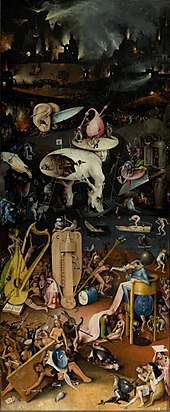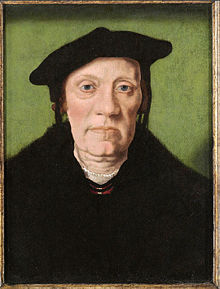Dutch and Flemish Renaissance painting

Dutch and Flemish Renaissance painting represents the
Dutch and Flemish painters were also instrumental in establishing new subjects such as

Stylistic evolution
Italian Renaissance influences begin to show on Early Netherlandish painting around 1500, but in many ways the older style was remarkably persistent. Antwerp Mannerism is a term for painters showing some Italian influence, but mainly continuing the style and subjects of the older masters. Hieronymus Bosch is a highly individual artist, whose work is strange and full of seemingly irrational imagery, making it difficult to interpret.[2] Most of all it seems surprisingly modern, introducing a world of dreams that seems more related to Gothic art than the Italian Renaissance, although some Venetian prints of the same period show a comparable degree of fantasy. The Romanists were the next phase of influence, adopting Italian styles in a far more thorough way.
After 1550 the Flemish and Dutch painters begin to show more interest in nature and beauty "in itself", leading to a style that incorporates Renaissance elements, but remains far from the elegant lightness of Italian Renaissance art,[3] and directly leads to the themes of the great Flemish and Dutch Baroque painters: landscapes, still lifes and genre painting - scenes from everyday life.[2]
This evolution is seen in the works of
Painters

- Pieter Aertsen
- Simon Bening
- Hieronymus Bosch
- Pieter Brueghel the Elder
- Pieter Brueghel the Younger
- Joachim Beuckelaer
- Joos van Cleve
- Pieter Coecke van Aelst
- Hieronymus Cock
- Corneille de Lyon
- Hans Eworth
- Frans Floris
- Maarten van Heemskerck
- Caterina van Hemessen
- Jan Sanders van Hemessen
- Adriaen Isenbrant
- Jan Mabuse van Gosaert
- Anthonis Mor
- Lucas van Leyden
- Lambert Lombard
- Quentin Matsys
- Jan Mostaert
- Bernard van Orley
- Joachim Patinir
- Frans Pourbus the Elder
- Pieter Pourbus
- Jan Provoost
- Marinus van Reymerswaele
- Jan van Scorel
- Levina Teerlinc
- Jacob van Utrecht
See also
| History of Dutch and Flemish painting |
|---|
| Periods |
|
| Lists |
- Renaissance in the Netherlands
- Northern Renaissance
Notes
- ^ Snyder, 409–412, 432–445
- ^ ISBN 0-8109-3442-6.
- ^ ISBN 90-5035-222-7.
References
- ISBN 0-13-623596-4.
Further reading
- Orenstein, Nadine M., ed. (2001). Pieter Bruegel the Elder: Drawings and Prints. ISBN 978-0-87099-990-1.
External links
 Media related to Northern Renaissance paintings at Wikimedia Commons
Media related to Northern Renaissance paintings at Wikimedia Commons
